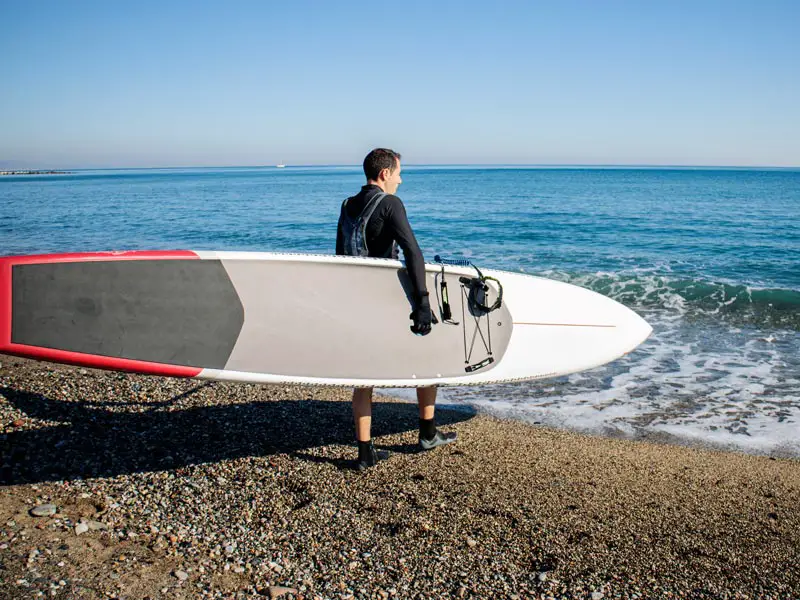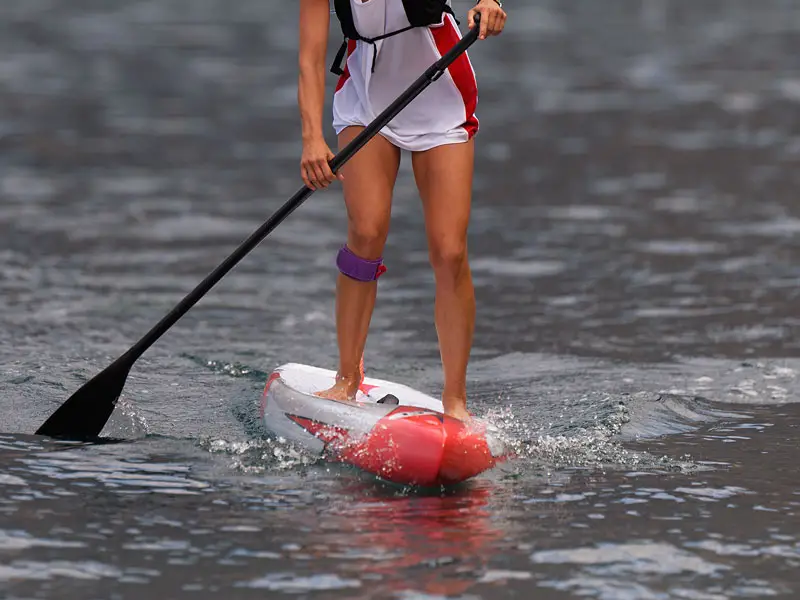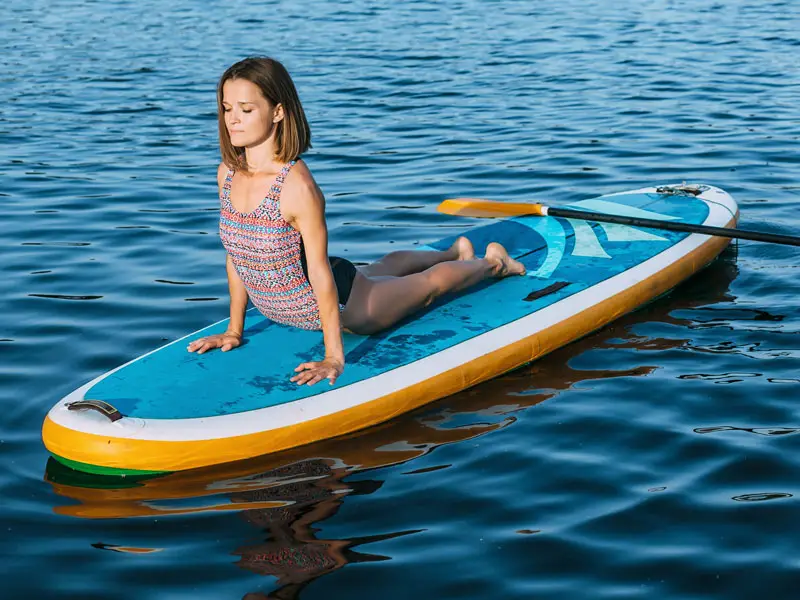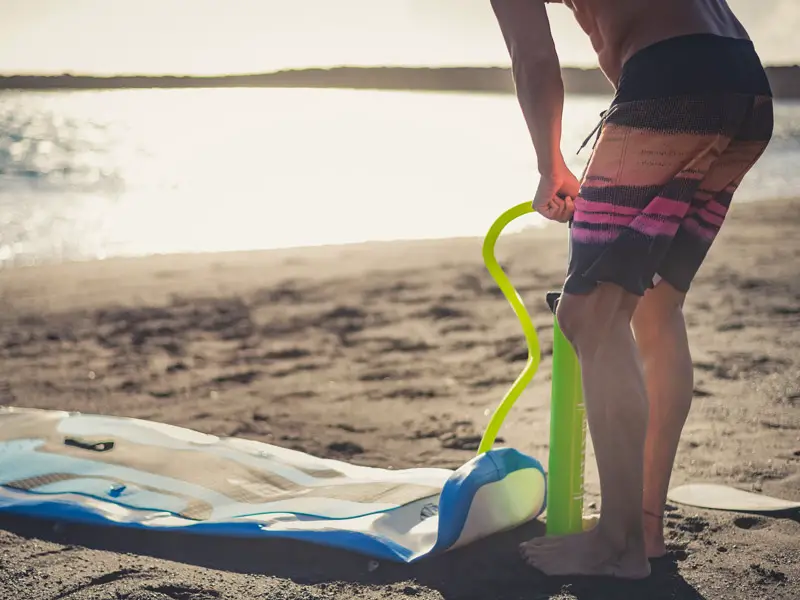So, you’ve tried your hand at paddle boarding a couple of times and enjoyed it. Maybe you rented one at the beach on vacation or had a go with a friend’s board on the lake. You think to yourself, “this could be the sport for me,” and you are right, it can be!
You decide to take the plunge and buy your first paddle board. So you do a quick search online, ready for your perfect new board to arrive in 2-5 days. But wait! You never realized that there were so many varieties of paddle boards, different shapes, materials, and uses. You don’t have a clue how to pick a paddle board that is right for your needs.
Don’t worry, here we give you the lowdown on what you need to look out for, and how to pick a paddle board.
What Is A Paddle Board?
A stand-up paddle board is larger than a surfboard, it lets you float on the water and propel yourself with a single-bladed paddle. Stand up paddle boards, also known as SUPs come in different types, shapes, and sizes. From hard boards to inflatable ones, you can find any option to suit your requirements.
For all the right reasons, standup paddle boarding is emerging as one of the most loved water sports and is currently the fastest-growing watersport in the world. Paddle boarding is a fantastic low impact full-body workout, is fun, and the vibes of being out on the water are unmatchable.
Types Of Stand Up Paddle Boards
Stand-up paddleboarding as a sport has evolved into many different disciplines in recent years, and as a result, there is a wide range of different types of paddle boards available to buy. Every type of board has a certain purpose and is designed with specific characteristics to allow it to perform. All you need is to do is to sort out your requirements and then go for a type that looks the most promising to you.
The first step in how to pick a paddle board is deciding what you are going to be using it for. The most common types of stand up paddle board disciplines are:
- All-around Paddling
- SUP Surf
- Paddle Board Touring
- SUP Racing
- SUP Yoga
All-around Stand Up Paddle Boards
As the name suggests, all-around boards are the jack of all trades. They are by far the most popular style of paddle board by volume sold and are usually the first type of stand up paddle board that people use. If you are completely new to paddle boarding, I would suggest starting with an all-around.
All-around stand up paddle boards can serve most purposes reasonably well. They can be paddled short to medium distances, surfed in small waves and are wide and stable enough to atempt a few yoga poses. These boards are usually between 10′-11′ in length, over 32″ in width and have a rounded nose.
They are stable, wide, and have a large weight capacity, so they are great for learning or just playing about in the water. Although, due to these characteristics, they do not make good racing boards and are quite slow.

SUP Surfing Paddle Boards
If you want to get serious about surfing some waves, a surf specific paddle board will be perfect for you. These types come with a relatively narrow tail and nose and are shorter, usually less than 9′ in length. This variance in shape is for a reason, the narrow ends will allow the user to get more control of the board. Hence, the paddler will be able to turn the board sharply when surfing a wave.
However, due to the short length and low volume, these types of paddle boards won’t hold much speed when they are not surfing a wave. Moreover, if you do try paddling a SUP-surf board on flat water, they may not prove to be too stable and won’t track as well in a straight line.

Touring Paddle Boards
If you want to cover long distances on your board, the best option to choose is known as a flatwater or touring paddle board. Touring boards are faster and have superior tracking compared to most others. They also have decent stability, weight capacity, and cargo space, making them perfect for multi-day camping trips.
Touring boards are longer than all-around boards, usually between 11′ – 13′ in length and varying between 28″ – 34″ in width, depending on the paddler’s preference. They have a more pointed nose designed to punch through small waves and chop without losing speed as a more rounded nose would.

Racing Paddle Boards
If you are a serious paddler and want to compete, then race paddle boards are there for you. They are longer stand narrower than most other boards, with the standard race sizes being 12’6″ and 14′ in length and as narrow as 21″.
When compared to all-around or touring, race boards are fast, seriously fast. However, they are not suitable for a casual paddle boarder. Because of their narrow width, they are pretty unstable and designed to be used by athletes at the top of their game, often with a price to match.

Yoga Paddle Boards
Although you can try to practice yoga on any board, the phenomenon of paddle board yoga has been so huge in recent years that board manufacturers have started designing and producing yoga specific models. These yoga paddle boards are wider, sometimes even rectangular, with a soft mat-like covering across the entire surface. Yoga paddle boards are very stable, and more like a floating yoga mat than a paddle board.
The features that make yoga paddle boards a great aquatic studio have the opposite effect when it comes to paddling ability. Don’t expect to win any races with a yoga board, but if you are planning to start paddle yoga, it might be the perfect paddle board for you.

Which One To Go For – Inflatable Or Hard Paddle Boards?
Another major factor to consider is whether you want a hard board or an inflatable one. Both have pros and cons, but will depend on your individual circumstances and needs to which you should get.
Hard Paddle Boards:
As their name suggests, hard paddle boards are ridged and solid, opposed to inflatables which can be folded once deflated. The most common construction of hard boards is an EPS (expanded polystyrene) foam core and epoxy fiberglass or carbon-fiber covering. Some in this construction also feature wood or bamboo veneer under the epoxy. Cheaper hard boards are constructed from plastic that is injection molded, known as “pop-outs”.
Advantages:
- Performance: When it comes to performance, solid paddle boards have the advantage. They flex less than an inflatable paddle board, allowing you to transfer more power from your paddle stroke into forwarding momentum.
- Better Hull Shape: The shape of solid boards are not limited by their materials like inflatable boards. This allows designers to add optimal rocker (the curve from nose to tail), and to have a more streamlined nose to cut through the water.
- No Set-up Time: With hard boards, they don’t require pumping up before use. Just remove it from your car roof rack, put it in the water and you are ready to paddle.
Disadvantages:
- Difficult to Store and Transport: Hard stand up paddle boards don’t pack away small like inflatables. If you are living in a city apartment or only have a small car (or no car at all), you will struggle with a hard board.
- They Are Hard: When you are learning to paddle board Falling is just a fact of life. Falling and landing on a hard board will hurt more than an inflatable. Of course, you should try to fall away from your board, but it doesn’t always work like that.
- They Are More Expensive: While cheap boards exist with both hard and inflatable paddle boards, The same quality of hard board will be more expensive. As explained in why are paddle boards so expensive, This is due to a number of things, such as the cost of materials, storage, shipping, and manufacture.
Inflatable Paddle Board:
Inflatable paddle boards, sometimes known as ISUPs are made from high quality PVC and use woven fibers called drop stitching to prevent them becoming balloon shaped when inflated.
They are nothing like typical inflatable toys, and can be inflated to high pressures which provides ridgidity. Most inflatable paddle boards range from 12 – 18 PSI, but high end ones can take as much as 30 PSI.
Advantages:
- Portability and Storage: Inflatable stand up paddle boards can be deflated, rolled up into their carry bags, and fit into the trunk of a small car or a wardrobe. This is fantastic if you are short of space. The carry bags usually have backpack straps or wheels, allowing you to carry the board longer distances to the water.
- Tough and Hardwearing: Yep, you read that right, inflatable paddle boards are actually tougher than hard boards. Provided you have a decent inflatable board with multiple layers of PVC, it will withstand knocks and drops much better than a hard board which could crack on impact.
- More Affordable: Inflatable paddle boards are easier on the wallet than hard boards. In fact, all of the boards in our our pick of the best budget stand up paddle boards are inflatable.
Disadvantages:
- Set-Up Time: Unfortunately, they take some time to inflate before use. Almost all inflatable boards come with a manual pump that will take between 8 – 15 mins of pumping to fully inflate. If you are not so keen on the idea of sweating it out under the hot sun every time you want to use your board, there are electric paddle board pumps as well.
- Rigidity: While most inflatable boards are pretty rigid, this is where hard boards will always triumph. However, in most cases the rigidity of inflatable boards is more than enough.

How To Choose A Paddle Board Size?
When choosing a paddle board size, you have to look at the length, width, thickness, and ultimately the volume when making your decision. These factors are not set and will change depending on your body weight, paddling ability, and the discipline of paddle boarding you are doing.
Length Of Paddle Board
Perhaps the most obvious factor when choosing a paddle board, the length has a huge impact on how well a board will handle. A longer paddle board will be faster and have better tracking. Tracking is the ability to maintain a straight course without correction. This is why touring and race boards are longer. On the flip side, a longer board will be less maneuverable, requiring more paddling to turn.
Paddle Board Width
The width of a paddle board is the main factor in stability. The wider a board, the easier it will be to balance, although width increases the wetted area of the board creating drag, slowing you down. A compromise is needed, you want a board that offers adequate stability for your abilities and body weight when searching for a paddle board.
As a general rule of thumb, 32″ – 34″ in width is stable enough for a beginner to learn on. If you are taller than average, you can opt for a slightly wider board, and if you are quite short, 30″ may be enough. As you advance in your abilities and balance, you may want to trade-in for a narrower model. My advice is to do this in 2-inch increments.
If your board is too wide, then you may have problems reaching your paddle over the side and maintaining proper form. Try to experiment with a few sizes and see what feels best.
Paddle Board Thickness
The thickness doesn’t really impact a paddle board’s handling or speed, like the length and width. The thickness is all about how much volume the board can displace, and ultimately how much weight of paddler and cargo it can carry.
For example, if you have two identical boards, but one is 4″ thick and the other is 6″, The thicker board will have a volume of 50% more than the thinner one.
If the board is too thick, then you may have difficulty balancing due to the raised center of gravity. However, this only usually affects taller paddle boarders.
Volume Of The Board
When looking at a paddle board, the volume is one of the most important factors. Volume is the total amount of space inside a board and directly relates to the amount of flotation it will provide.
It is also one of the only size factors that we can apply a formula to calculate the approximate size needed. For this, you need to know your body weight in kilograms, KG.
Why KG you ask? Because 1 litre of water weighs 1KG. For those of you that don’t work in metric, there are 2.2 lbs to 1KG.
On a flatwater board such as an all-around or touring, to get an approximate minimum volume you should multiply your body weight in KG by 2.5 for beginners and 2.2 for advanced paddlers. Remember that if you are carrying gear with you, factor this into the calculation.
| Rider Weight In KG | Volume For Beginner Paddler In Litres | Volume For Advanced Paddler In Litres |
|---|---|---|
| 65 | 165 | 140 |
| 70 | 175 | 155 |
| 75 | 190 | 165 |
| 80 | 200 | 175 |
| 85 | 215 | 190 |
| 90 | 225 | 200 |
| 95 | 240 | 210 |
Other Factors To Consider:
In our guide on how to pick a paddle board, how can we only provide you limited information? Getting to know about the sizes and types of stand up paddle boards is not enough to get the best one. There are other factors that you need to consider as well. So, let us get you through them as well.
Deck Pad
The surface of the board is another important thing that you should consider before buying your paddle board. If the board’s surface is slippery or uncomfortable, you won’t be able to enjoy your adventure. So, for a safer and more enjoyable experience, go for a board with a grippy but comfortable deck pad. If you are looking to do some yoga, this will be even more important.
Included Gear
Well, it’s all about paddling, isn’t it? So, you are going to need a paddle. Lots of paddle boards come as a whole kit, with paddle, pump, leash, and carry bag included in the price. Some, particularly hard boards don’t come with anything. Make sure you factor this in as it can significantly increase the price once you start adding it all up.
It is also worth looking at the quality of the gear included. some will only come with cheap aluminum and plastic paddles and single action pumps. this is an area that manufacturers can skimp on costs.
Aesthetics
Whoever told you looks don’t matter was lying. Now, I’m not telling you to buy a paddle board on looks alone, but you should like the look of it. You are hopefully going to be using it often, therefore you will want to get something that matches your style. Most boards come in a range of colors, so you should be able to find something you like.
Warranty
A well looked after paddle board should last for years, but occasionally manufacturers make mistakes in production. Decent brands usually have a long warranty period to put your mind at rest. The Bluefin Cruise has a staggering 5-year warranty, but a general average would be around 2-years.
The Bottom Line:
Hopefully, this guide will have shined a little more light on the many types of stand up paddle boards, and given you some pointers on how to pick a paddle board. Whatever board you pick, make sure it fits your needs.
If you are new to the sport, make sure you understand the possible dangers of stand up paddle boarding, and how to stay safe.
